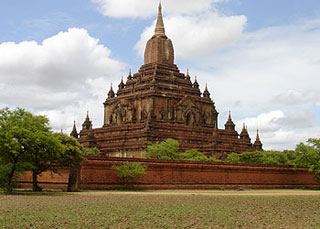Sulamani Temple is located in Minnanthu region. in the center of Bagan. The temple was built by King Narapatisithu in 1183 AD. It is a cave pagoda and massive in Structure. It’s entrance was decorated by Superb architectural works of art.
Like the Htilominlo and the Gawdawpalin this is a prime example of later. more sophisticated temple style. with better internal lighting. It stands beyond the Dhammayangyi Temple and was built in 1181 by Narapatisithu. The interior was once painted with fine frescoes but only traces can be seen today.


This temple is one of Bagan’s premier temple attractions. The name itself means Crowning Jewel or Small Ruby. It was the first and most important temple of the late period (1170-1300) of Bagan monument building. It was one of many temples and stupas built by Narapatisithu. This temple is similar to Htilominlo and the Gawdawpalin in architecture but with better interior lighting. It stands beyond the Dhammayangyi Temple. Important features of the Sulamani include its fine brickwork and use of stone in both load-bearing areas as well as on vulnerable external corner elements. The interior was once painted with fine frescoes but only dim traces can be seen today.
Combining the horizontal planes of the early period with the vertical lines of the middle. the temple features two storeys standing on broad terraces assembled to create a pyramid effect. The brickwork throughout is considered some of the best in Bagan. Some part of the temple was damaged during 1975 by the earthquake. Pagodas stand at the corners of each terrace. and a high wall. fitted with elaborate gateways at each cardinal point. encloses the entire complex. The interior face of the wall was once lined with a hundred monastic cells. a feature unique among Bagan’s ancient monasteries.


Sulamani represents some of Bagan’s finest ornamental work which are carved stucco on mouldings. pediments and pilasters. These are today in fairly good condition. Glazed plaques around the base and terraces are also still visible. Buddha images face the four directions from the ground floor; the image at the main eastern entrance sits in a recess built into the wall. The interior passage around the base is painted with fine frescoes from the Konbaung period. and there are traces of earlier frescoes. Stairways lead very close to the top of this temple. from where the views are superb. In the north of the compound contains the remains of Sulamani Kyaung. a monastery building that housed Sulamani’s senior monk and the Tripitaka (the Buddhist scriptures). which is walled enclosed. It may also have served as an ordination hall. A water tank in the compound is thought to be the only original Bagan reservoir.


Nearby Attractions
PYATHATGYI
Southeast of the Sulamani is another ancient pagoda. known as the Pyathatgyi. Usually these monasteries were built out of wood.

